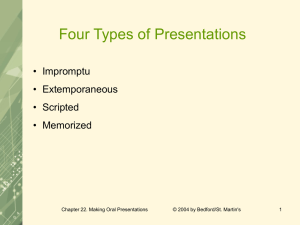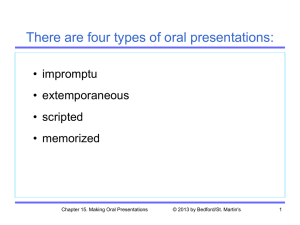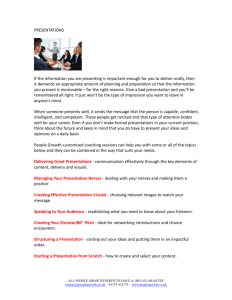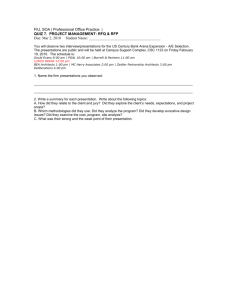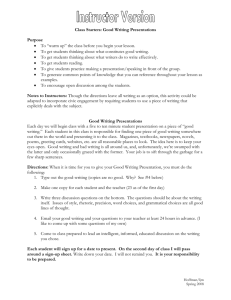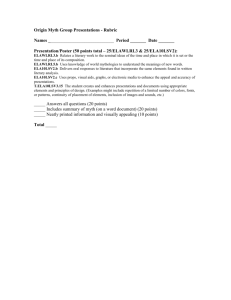There are four types of oral presentations
advertisement
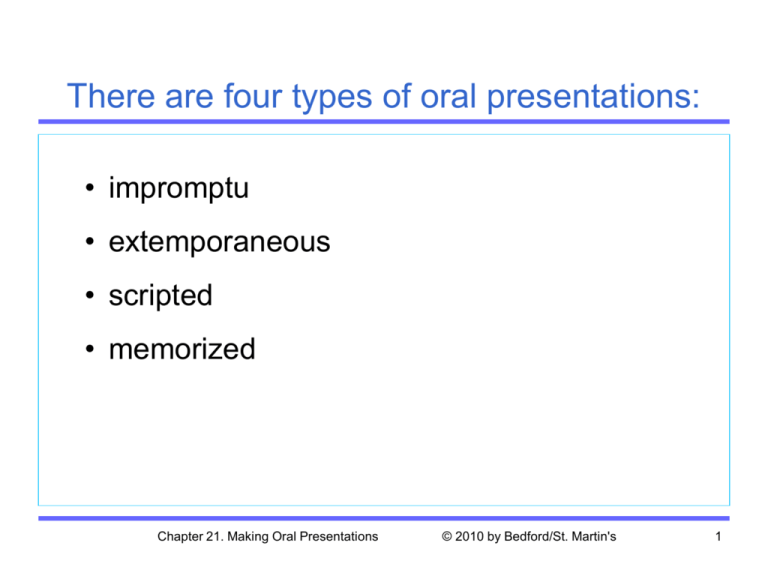
There are four types of oral presentations: • impromptu • extemporaneous • scripted • memorized Chapter 21. Making Oral Presentations © 2010 by Bedford/St. Martin's 1 You will deliver presentations to four types of audiences: • clients and customers • colleagues in your organization • fellow professionals at technical conferences • the public Chapter 21. Making Oral Presentations © 2010 by Bedford/St. Martin's 2 Preparing and delivering an oral presentation consists of six steps: • Analyze the speaking situation. • Organize and develop the presentation. • Prepare the presentation graphics. • Choose effective language. • Rehearse the presentation. • Deliver the presentation. Chapter 21. Making Oral Presentations © 2010 by Bedford/St. Martin's 3 Here is the typical time allotment in a 20-minute presentation: Task Introduction Body First major point Second major point Third major point Conclusion Questions Chapter 21. Making Oral Presentations Time (minutes) 2 4 4 4 2 4 © 2010 by Bedford/St. Martin's 4 Follow these five guidelines in introducing a presentation: • • • • • Introduce yourself. State the title of your presentation. Explain the purpose of the presentation. State your main point. Provide an advance organizer. Chapter 21. Making Oral Presentations © 2010 by Bedford/St. Martin's 5 Follow these four guidelines in concluding a presentation: • • • • Announce that you are concluding. Summarize the main points. Look to the future. Invite questions politely. Chapter 21. Making Oral Presentations © 2010 by Bedford/St. Martin's 6 An effective graphic has five characteristics: • It presents a clear, well-supported claim. • It is easy to see. • It is easy to read. • It is simple. • It is correct. Chapter 21. Making Oral Presentations © 2010 by Bedford/St. Martin's 7 In planning your graphics, consider four aspects of the speaking situation: • length of the presentation • audience aptitude and experience • size and layout of the room • equipment Chapter 21. Making Oral Presentations © 2010 by Bedford/St. Martin's 8 Select from the six basic media for presentation graphics: • • • • • • computer presentations slide projector overhead projector chalkboard or other hard writing surface objects handouts Chapter 21. Making Oral Presentations © 2010 by Bedford/St. Martin's 9 There are two reasons to choose effective language for a presentation: • Listeners can’t go back to listen again to something they didn't understand. • Because you are speaking live, you must maintain your listeners’ attention, even if they are hungry or tired or the room is too hot. Chapter 21. Making Oral Presentations © 2010 by Bedford/St. Martin's 10 Use language to signal three kinds of presentation elements: • advance organizers • summaries • transitions Chapter 21. Making Oral Presentations © 2010 by Bedford/St. Martin's 11 Follow these three guidelines for using memorable language: • Involve the audience. • Refer to people, not to abstractions. • Use interesting facts, figures, and quotations. Chapter 21. Making Oral Presentations © 2010 by Bedford/St. Martin's 12 Concentrate on three aspects related to the mechanics of delivering a presentation: • Calm your nerves. • Use your voice effectively. • Use your body effectively. Chapter 21. Making Oral Presentations © 2010 by Bedford/St. Martin's 13 Think about these six points to help calm your nerves: • You are much more aware of your nervousness than the audience. • Nervousness gives you energy and enthusiasm. • After a few minutes, your nervousness will pass. • Realize that you are prepared. • Realize that the audience is there to hear you, not to judge you. • Realize that your audience is made up of individual people who happen to be sitting in the same room. Chapter 21. Making Oral Presentations © 2010 by Bedford/St. Martin's 14 Take these four steps to release nervous energy: • • • • Walk around. Go off by yourself for a few minutes. Talk with someone for a few minutes. Take several deep breaths, exhaling slowly. Chapter 21. Making Oral Presentations © 2010 by Bedford/St. Martin's 15 Pay attention to five aspects of vocalizing: • • • • • volume speed pitch articulation nonfluencies Chapter 21. Making Oral Presentations © 2010 by Bedford/St. Martin's 16 Follow these four guidelines for facing an audience: • • • • Maintain eye contact. Use natural gestures. Don’t block the audience’s view of the screen. Control the audience’s attention. Chapter 21. Making Oral Presentations © 2010 by Bedford/St. Martin's 17 Be prepared for these four problems you might encounter in answering questions: • You’re unsure everyone heard the question. • You don’t understand the question. • You get a question that you have already answered in the presentation. • A belligerent member of the audience rejects your response and insists on restating his or her original point. Chapter 21. Making Oral Presentations © 2010 by Bedford/St. Martin's 18


